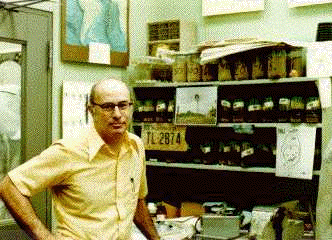
Research Professor of Geology
A.B., A.M., Ph.D. Harvard 1952,1953,1956
Geology Department, Union College
| Union Home |
| Env. Science |
| Geology Dept. |
| Fission track Lab |
| Tracks to Innovation |
Robert L. Fleischer passed away on March 3, 2011 after a long illness. Bob was a well-renowned scientist who made his name at GE’s Research and Development Lab, and in that time was involved in the research effort that led to fission-track dating and many other scientific discoveries. After retiring from GE, he spent many years at the Geology Department at Rensselaer Polytechnic Institute, and he then joined the Geology Department at Union College in the late 1990s. We have lost a close colleague who has been an integral part of our department and a scientific inspiration. Bob’s recent research was mostly in the area of radioactivity in the environment and this work has included measuring radon exposures of individuals and neutron exposures at ground zero at the time of the Hiroshima bombing. His most recent book entitled: Tracks to Innovation - Nuclear Tracks in Science and Technology (Springer-Verlag) details how particle tracks in solids have been used in a number of different ways, including fission-track dating. There will be no funeral, but a Memorial Service is scheduled for Sunday, March 13, 2011 at 1:00 p.m. at Temple Gates of Heaven in Schenectady, NY (USA). His obituary can be read at the Times Union of Albany. _________________________ His recent research was largely in the area of environmental radiation -- particularly radiation from the "noble" gas radon, which is derived from uranium in the earth. Radon is both a hazard (in homes and mines) and also a useful tool as a tracer for locating mineral resources and studying earthquakes. An opportunity exists for doing personnel dosimetry by using eyeglass lenses that commonly are made of a plastic called CR-39 --the usual material for eyeglasses in the U.S. Such lenses are recorders of the alpha particles that are released by radon and its polonium daughters.
. Recent Publications Tracks to Innovation - Nuclear Tracks in Science and Technology, R.L. Fleischer, Springer-Verlag, New York (1998), 210 pages. “Eyeglass Lenses for Personel Radon Dosimetry,” S. A. Hadley, N. R. Meyer, R. L. Fleischer, and A. Cavallo, Health Physics 79(2000) 242-250. “Uncertainties in Retrospective Radon Exposure of Glass: Possible Effects Hydration and of Leaching, R. L. Fleischer and R. H. Doremus, Health Physics 81, 110-113 (2001). “Hiroshima Neutron Fluence at a Glass Button from Near Ground Zero,” R. L. Fleischer, S. Fujita, and M. Hoshi, Health Physics 81, 720-723 ( 2001). Meyer, J. MacDonald, and A. Cavallo, Radiation Protection Dosimetry 97, 251- 258(2001). “Ion Tracks in Intermetallic Compounds” R. L. Fleischer, in Intermetallic Compounds- Principles and Practice, Vol. 3, J.H. Westbrook and R.L. Fleischer, eds., J. Wiley and Sons, Chichester, UK, Chapter 14, pp 263-273, Volume 3 (2002). “Intermetallic Compounds-Principles and Practice,” J.H. Westbrook and R.L. Fleischer, eds., J. Wiley and Sons, Chichester, UK, Volume 3 (2002). “Use of Glazes on Porcelain from Near Ground Zero to Measure Hiroshima Neutron Fluence,” J. MacDonald, R. L. Fleischer, S. Fujita, and M. Hoshi, Health Physics 85(4), 428-432 (2003). “On Search and Identification of Short-Lived Super-Heavy Cosmic-Ray Nuclei (Z>110) by Fossil Track Study of Extraterrestrial Crystals: Results and Perspectives (I)”. V.P. Perelygin, Yu.V. Bondar, W. Ensinger, R.L. Fleischer, P. Vater, and S.G. Stetsenko. Nuclear Physics A178, 410-412. (2003). “Recoil Tracks in Solids,” R. L. Fleischer , Geochimica et Cosmochimica Acta 67 (#24) 4769-4774 (2003). “Fission Tracks in Solids – Production Mechanisms and Natural Origins”, R. L. Fleischer, J. Materials Science 39, 3901-3911 (2004). “Does Maskelynite Imply Anything About Impact Craters?” Robert L. Fleischer, Meteoritics and Planetary Science 39 (#12), 2055 ( 2004). “Nuclear Tracks and Nanostructures,” R. L. Fleischer, Chapter 10 in Engineering Thin Films and Nanostructures with Ion Beams, Emile Knystautas, ed., CRC, Marcel Dekker, New York , pp.491-522 (2005). “Studies in Nuclear Tracks at Union College,” Robert L. Fleischer, Sekyung Chang, Jeremy Farrell, Stephen A. Hadley, Rachel C. Herrmann, Jonathan MacDonald, Nicholas R. Meyer, Marek Zalesky, and Robert H. Doremus, Acta Physica et Chimica Debricina 38-39, 141-152 (2005). “Are tracks caused by thermal spikes?” R. L. Fleischer, Int. Nuclear Track Soc. Newsletter 5 (#2), 2-3 (2005). “Etched Tracks and Serendipitous Dosimetry,” Robert L. Fleischer, Sekyung Chang, Jeremy Farrell, Rachel C. Herrmann, Jonathan MacDonald, Marek Zalesky, and Robert H. Doremus, Radiation Protection Dosimetry, 120, 450-456 (2006). . . . . .
|
| 4 March 2011 | ||
+1, 518-388-6985(Office)
Email: geology@union.edu
|
||
All rights reserved. No part of the document can be copied and/or redistributed, electronically or otherwise, without written permission from: Chair of Geology, Union College, Schenectady NY, 12308-2311, USA.
Last Revised:
5 March, 2011
.
